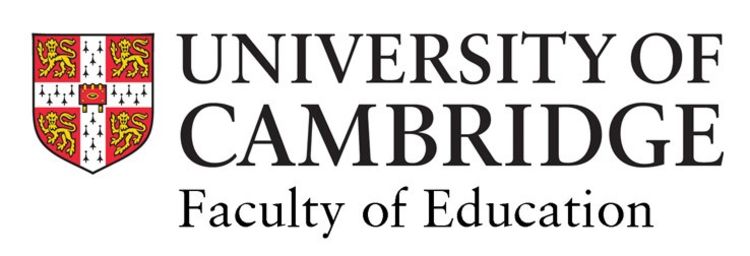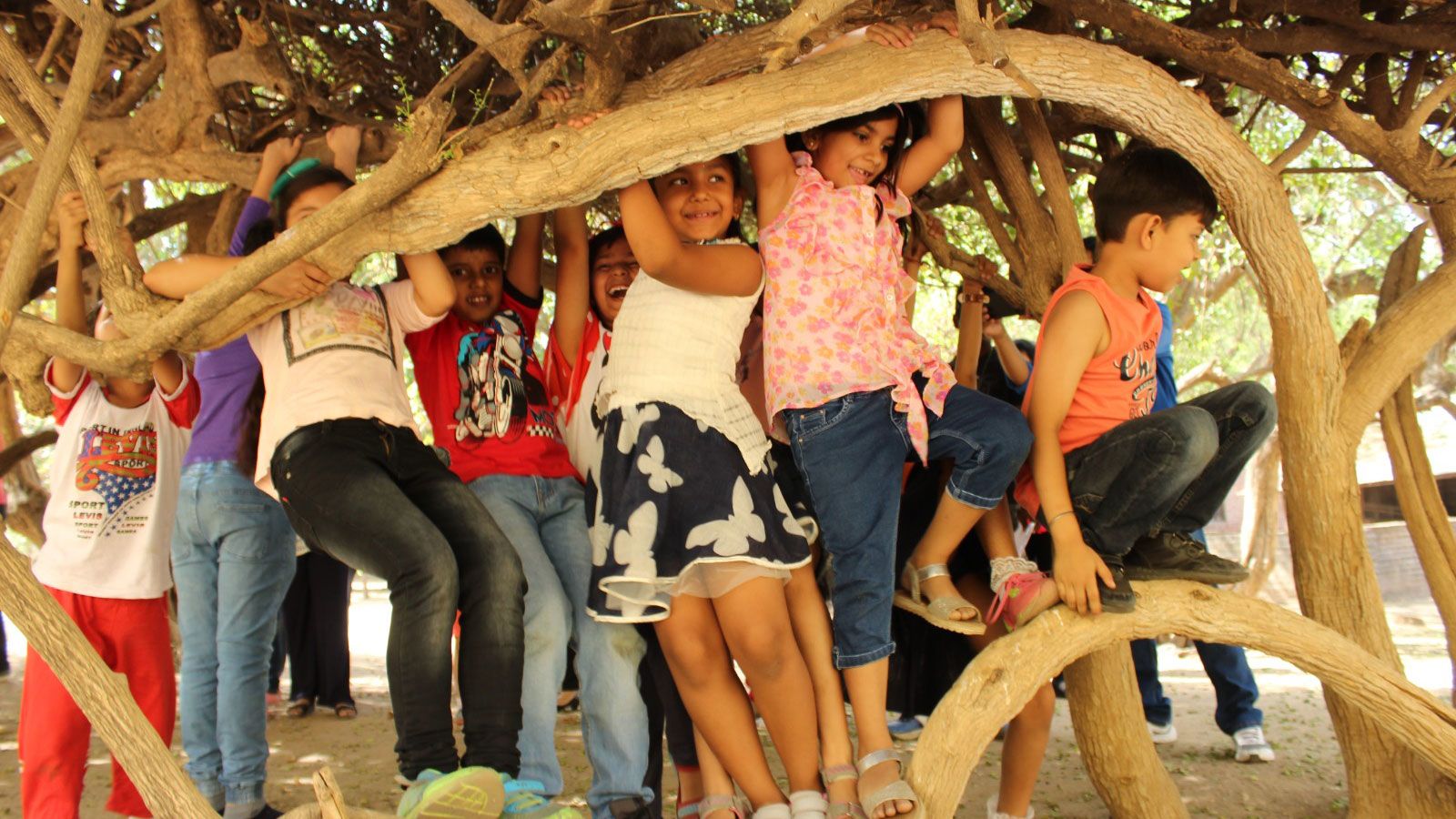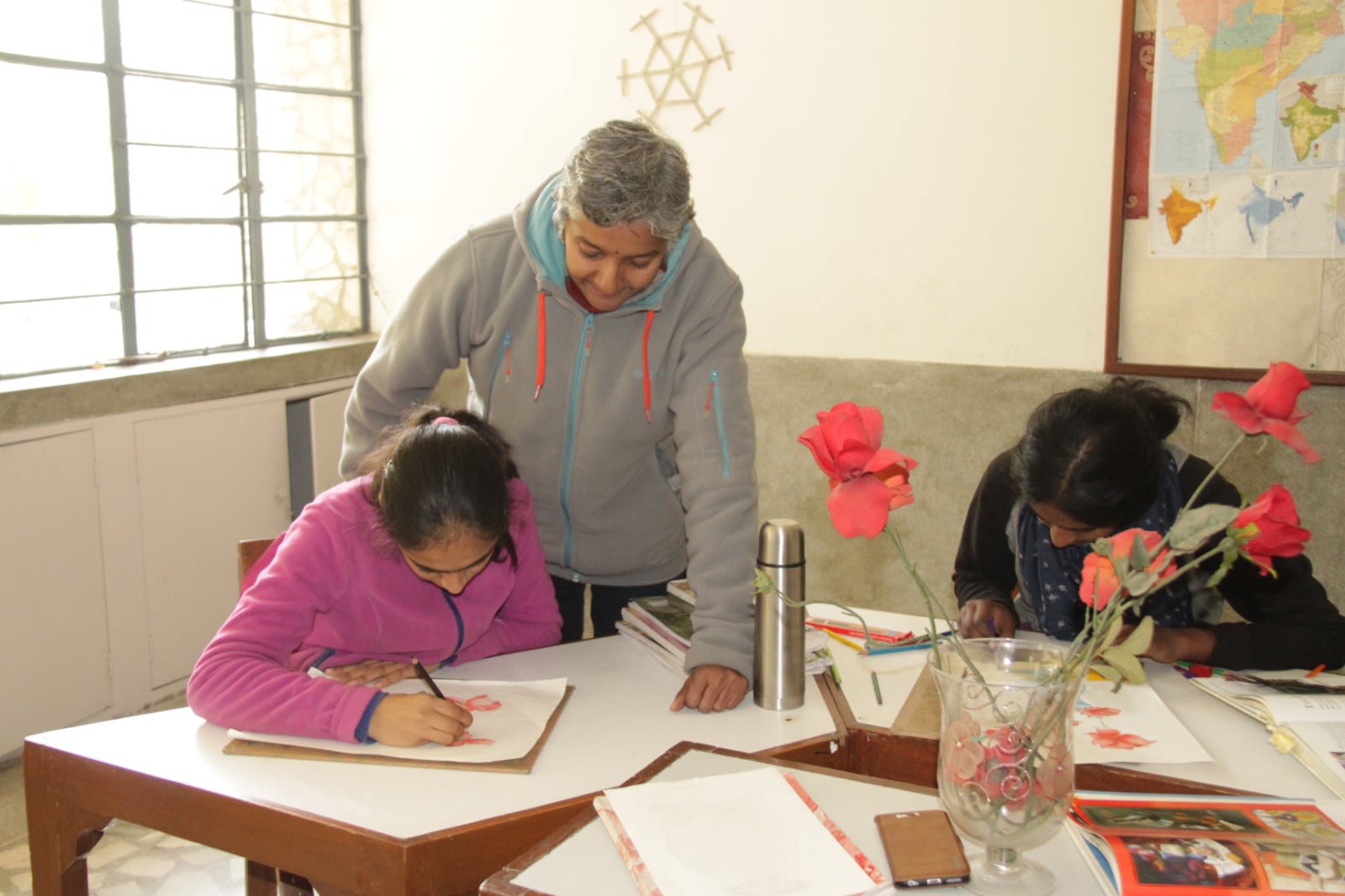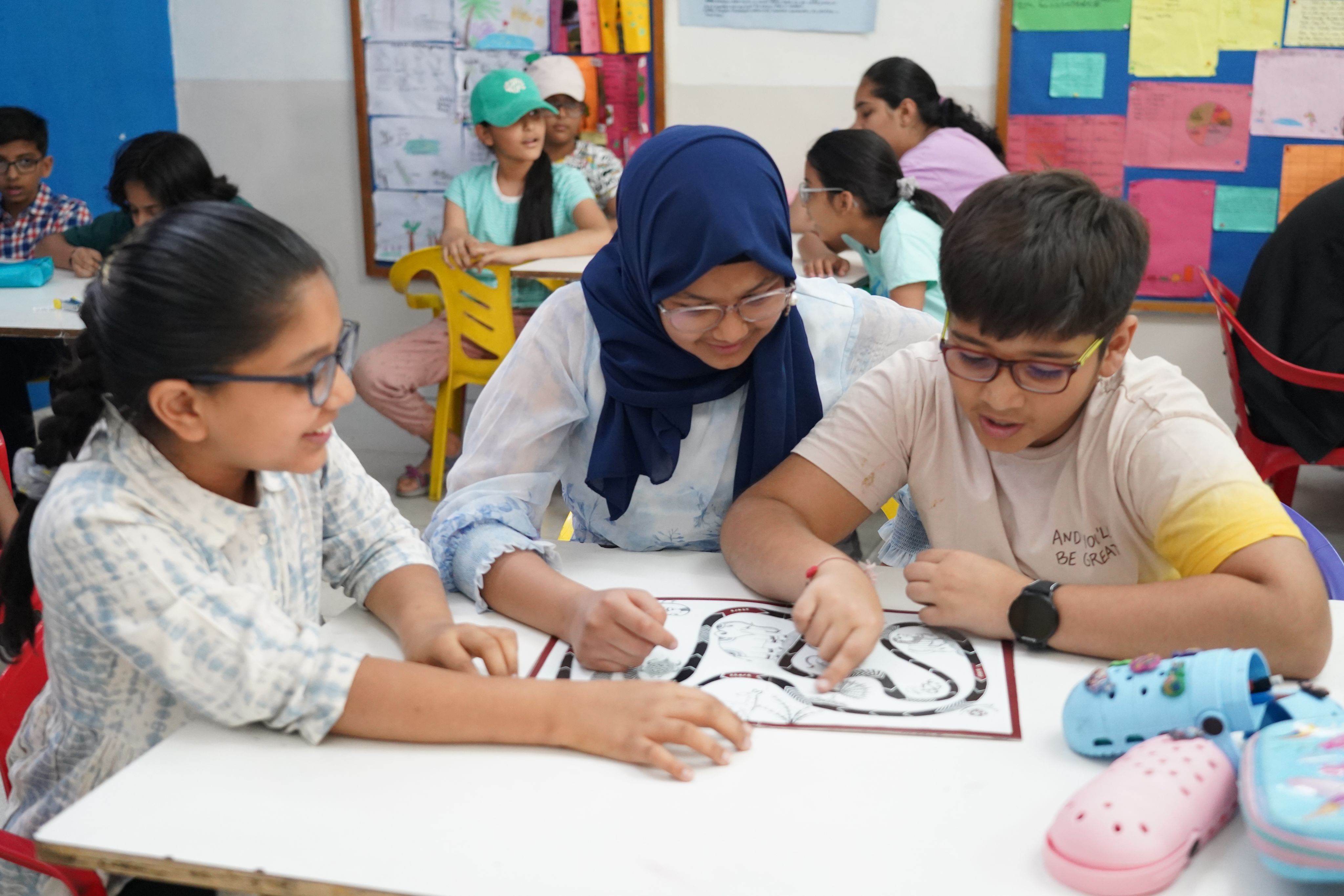

Educating for Harmony

In places such as the streets of Ahmedabad and the rolling hills of Andhra Pradesh, a group of schools has been nurturing generations of bright, young, Indian minds, who frequently become leaders in their fields. Yet to a Western observer, the most remarkable aspect of these institutions may not be their accomplishments, but their divergence from traditional norms.
In defiance of the benchmarks of educational ‘excellence’ in countries like the United Kingdom, these schools embrace an unconventional approach.
Predetermined curricula may be eschewed in favour of what one prospectus calls “the naturally evolving rhythm of learning”. Academic learning is valued, but on an equal footing with teamwork, socio-emotional development, and supporting the local community. Activities like fundraising, countryside walks and participating in local agriculture matter just as much as passing exams.
These are India’s ‘alternative’ schools. They were inspired by philosophers and social reformers such as Mahatma Gandhi, Aurobindo Ghose, Rabindranath Tagore, and Jiddu Krishnamurti. While they are variously state or privately run, they have the freedom to operate independently of most government guidelines and operate as centres of educational experimentation, emphasising students’ autonomy, spiritual values, personal identity, self-respect and social belonging.
Many, though, have outstanding academic records. Schools like Mirambika Free Progress School in Delhi and Rishi Valley School in Chittoor frequently appear on lists of the best in India. Students often go on to study at top universities. Alumni from such schools include a former president, a former prime minister and a Nobel Prize-winner, alongside parliamentarians, chief justices, journalists, architects, entrepreneurs, artists and engineers.
Although Britain does not have the same tradition of alternative education and it is difficult to envisage any model of this type succeeding at scale, a new study suggests that Indian alternative education could nevertheless offer insights for educators in the West who want to rethink their practice. The book has been written by the academic Dr Jwalin Patel, who studied 21 alternative schools as a researcher at the Faculty of Education, University of Cambridge. In five schools, he also spent extended periods living and working on campus, observing life and interviewing students and teachers. He argues that, even though it cannot be fully replicated, certain aspects of the alternative model could help address concerns about education in Europe and North America. International organisations and educators have long urged Western systems to focus more on social skills, character education and citizenship. Notably, the United Nations’ concept of ‘Learning to Live Together’ (LTLT), which is linked to its 2030 Sustainable Development Goals, emphasises education which develops respect for other people, cultures and spiritual values.
I often questioned the purpose of the education I had received. Many of the most important skills and values – socio-emotional, entrepreneurial skills, sensitivity, empathy, compassion or gratitude, for example – I learned at home.
Patel suggests that modern, mass education has a considerable journey ahead of it to achieve that vision. Currently, the system often emphasises competitive testing, rote memorisation of facts, and top-down teaching methods that leave students with little agency. The book likens this to factory processes, with students resembling “mice preparing for rat races”.
These criticisms, while not new, often go unheard in policy circles, where LTLT is rarely mentioned. For Patel, they are rooted in personal experience. Growing up in India, he excelled at more traditional schools, before attending two top British universities – University College London and Cambridge. Now, however, he reflects that he emerged a “fragment” of his true self.
“I often questioned the purpose of the education I had received,” Patel said. “I don’t remember much of the academic content I learned and felt I would have preferred to know how to file my taxes, farm, improve social justice, or understand interconnectedness in the world. Many of the most important skills and values – socio-emotional, entrepreneurial skills, sensitivity, empathy, compassion or gratitude, for example – I learned at home.”
Patel suggests that modern, mass education has a considerable journey ahead of it to achieve that vision. Currently, the system often emphasises competitive testing, rote memorisation of facts, and top-down teaching methods that leave students with little agency. The book likens this to factory processes, with students resembling “mice preparing for rat races”.

These criticisms, while not new, often go unheard in policy circles, where LTLT is rarely mentioned. For Patel, they are rooted in personal experience. Growing up in India, he excelled at more traditional schools, before attending two top British universities – University College London and Cambridge. Now, however, he reflects that he emerged a “fragment” of his true self.
“I often questioned the purpose of the education I had received,” Patel said. “I don’t remember much of the academic content I learned and felt I would have preferred to know how to file my taxes, farm, improve social justice, or understand interconnectedness in the world. Many of the most important skills and values – socio-emotional, entrepreneurial skills, sensitivity, empathy, compassion or gratitude, for example – I learned at home.”
The contrast with conventional education is evident. At the Shreyas Foundation in Ahmedabad, for example, Patel found a school deeply integrated with nature, featuring green spaces and an on-campus Miyawaki forest often used for open-air teaching. At Patha Bhavana, Shantiniketan nearly all learning happens outdoors with teachers and students seated under trees. At Rishi Valley School, students explore a self-chosen project for a month each year, live within a forest and are continually immersed in nature; they also engage in activities like birdwatching and hiking. The Mahatma Gandhi International School and Mirambaka Free Progress School adopt transdisciplinary project-based learning throughout the year. In addition, Mirambika, while acknowledging the importance of learning “facts and figures” intentionally foregoes a set curriculum, dynamically adapting to individual students’ needs.
Based on his ethnographic stays, observations and interviews, Patel concludes that these methods develop students with distinct values and behaviours. “They perform well academically, but also seem to gain clearer self-understanding earlier,” he said. “One reason is the schools’ emphasis on fundamental skills like independent learning, which nurtures students who are naturally curious, motivated and driven.”

His book records “innumerable cases” of students sharing resources, looking after one another, and actively engaging with their environment. In one memorable episode, he recounts a field trip where students spontaneously decided to clear up litter that was scattered along their path.
He links these outcomes to aspects of social cognitive theory which propose that students develop skills, attitudes and behaviours by observing and mirroring others. Alternative schools succeed, he writes, because instead of treating citizenship as another teachable skill, they embody it in their everyday life. One teacher he interviewed aptly summarised this ‘lived experience pedagogy’ by stating that values should be “caught, not taught”.

The notion that we might overhaul education overnight and emulate these schools is clearly impractical – but that isn’t to say we shouldn’t learn from them.

Although British education is inadequately positioned to adopt these methods wholesale, Patel’s research highlights several pedagogical features that could inspire educators seeking a more rounded approach to nurturing compassionate, engaged, and responsible citizens. These include:
1. Student autonomy and a sense of collective responsibility: The schools embody a democratic ethos of freedom and autonomy, which seems to positively affect students’ intrinsic motivation. The idea of students having freedom of action was linked to a wider sense of (collective) responsibility; with students and teachers, alike, taking responsibility for the school and each other’s wellbeing.
2. Democratic approaches to behaviour management: Collaborative approaches to rule-making, for instance through student-run committees and group discussions, are commonplace. This appears to enhance students’ sense of ownership and responsibility. As one teacher explained: “The more restrictions you place, the more people want to break them… it should come from within”.
3. Group and project work: Student councils, assemblies and artistic projects are all important aspects of school life, and at classroom level, group work is often the norm.
4. Dialogic education: A focus on dialogue and problem-solving, which emphasises collaborative learning, is a central component of teachers’ practice. Teachers work hard to encourage diverse perspectives and create safe spaces for each student to voice their own thoughts.
5. Collaboration over competition: Schools generally avoid practices like academic streaming or putting marks on report cards, preferring qualitative feedback, to promote a sense of inclusion and acceptance, and an appreciation of diversity. All through Patel’s fieldwork competition was only referenced once, in the context of a water conservation competition when the local region faced a drought.
6. Silence and meditation: Structured ‘silent moments’ for contemplation are frequently integrated into the school day. Patel suggests this fosters calmness and emotional stability in students.
7. Social action: A strong emphasis on social action connects education to real-world issues. Within school, students undertake activities such as cleaning, feeding and caring for animals, or helping to conserve water and energy. Most schools also run awareness campaigns or fundraising activities with charities or their local communities – for example, those in rural locations run projects helping local farmers.
8. Community connections: Learning is considered a 24/7 experience, with schools actively engaging with the wider community and involving parents and local workers in school events. In addition, other community members like shoemakers, waste-pickers, mechanics, musicians and craftspeople visited the schools.
9. Nature as an educator: embodied lived experiences within nature and appreciation for nature are key components of school life, fostering a sense of interdependence with the environment.
10. Teachers trying to live harmoniously for themselves: Teachers didn’t merely model behaviours but engaged in a lifelong learning process of learning to live harmoniously for themselves. One teacher explained “The day I stop learning and growing inwards I will stop coming to the school”.
“The notion that we might overhaul education overnight and emulate these schools is clearly impractical – but that isn’t to say we shouldn’t learn from them,” Patel said. “Teachers might be surprised by how natural some of these practices are.”
“Crucially, none of these methods precludes the development of academic skills. Skills undoubtedly matter, but pursuing an education that fosters a better life beyond academic aptitude should not be framed as a trade-off. Many of the skills students gain from this approach, such as teamwork, are likely to be essential for their futures. If we fail to open our minds to different ways of improving education, we risk harming our students, our societies and the world, and most importantly ourselves as educators.”
Learning to Live Together Harmoniously: Spiritual Perspectives from Indian Classrooms, by Dr Jwalin Patel, is published by Springer.

Images in this story (top to bottom):
Children playing in tree, by permission of Shreyas Foundation; Students learning at Mirambika Free Progress School, by permission of Mirambika; Children walking in nature, by permission of Shreyas Foundation; Students running through trees, by permission of Shreyas Foundation; Student painting, by permission of Mahatma Gandhi International School;